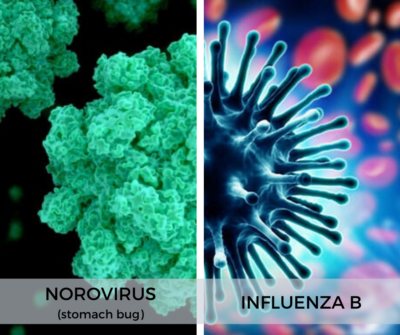 We use the word flu to describe a multitude of symptoms, but there are big differences in what we call the stomach bug (norovirus) and influenza. Both are viruses and neither will respond to antibiotics–so the best cure is plenty of rest and waiting for it to pass through your system. Here’s how to tell what you have and if you should go to the doctor:
We use the word flu to describe a multitude of symptoms, but there are big differences in what we call the stomach bug (norovirus) and influenza. Both are viruses and neither will respond to antibiotics–so the best cure is plenty of rest and waiting for it to pass through your system. Here’s how to tell what you have and if you should go to the doctor:
Norovirus (stomach bug) is very contagious and we generally see outbreaks between November and April. Symptoms include diarrhea, vomiting, nausea and stomach pain. Symptoms develop 12-48 hours after exposure. The virus is passed on through tiny particles of vomit or feces and can be transmitted by consuming contaminated food or water, touching contaminated surfaces and then your mouth (this is why handwashing is so, so, so important) and having direct contact with an infected person. Prevent this virus by washing your hands regularly, washing fruits and vegetables, cleaning and disinfecting surfaces and washing laundry, toys, etc. thoroughly to get rid of vomit or feces.
Norovirus is serious but most people feel better within one to two days. Young children, the elderly and people with other illnesses are most at risk. Severe cases of norovirus can lead to dehydration, hospitalization and, in extreme cases, death. Because it is passed easily through human contact, norovirus can spread quickly through closed places such as daycares, nursing homes and schools.
Hydration is key for infected individuals. If you or a family member have norovirus be sure to drink plenty of fluids and replace fluids lost through vomiting and diarrhea.
People with norovirus are contagious while they are actively sick and for the first few days after getting over the illness.
Influenza outbreaks peak between December and February. The virus can cause mild to severe illness which can lead to hospitalization or even death. Symptoms include fever, cough, sore throat, muscle or body aches, runny or stuffy nose, headaches or fatigue. Influenza is transmitted through droplets made when you cough, sneeze or talk and can be spread from up to six feet away. The best method of prevention for influenza is to get a flu shot. It’s generally good to get this in late October, but it’s never too late in the season for the vaccine to be effective.
It is important get a flu vaccine each year because flu viruses are constantly changing. It is not uncommon for new viruses to appear every year. Everyone at least six months of age should get an annual vaccine. People who are especially at risk for flu include those at high risk of developing serious diseases like pneumonia; people who have asthma, diabetes or chronic lung disease; pregnant women; people 65 years old and older; caregivers of high-risk individuals; people with HIV, cancer, heart disease or who have had a stroke.
Minor side effects from the flu shot include soreness, redness or swelling in the area of the shot; low grade fever; aches. These problems begin soon after the shot is given and usually last one to two days. Most people will not experience any problems from the vaccine.
So, when should you visit the clinic or ER? It’s time to come in when you can’t care for yourself (can’t make it to the bathroom, too weak to get around the house) or have a high fever. Fever associated with influenza can be as high as 102-104. You should see a provider if your fever is several degrees higher than your normal temperature and not relieved by over-the-counter medication. Children should see a provider if they aren’t able to participate as they normally would in daily activities.
If you are infected with influenza or norovirus, help prevent spreading the virus by avoiding close contact with others (stay home!), cover your mouth and nose when you cough or sneeze, clean your hands often, avoid touching your eyes, nose or mouth, and practice other healthy habits staying active, eating right and getting enough sleep.
